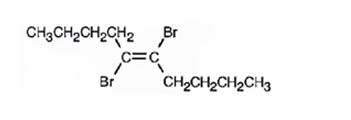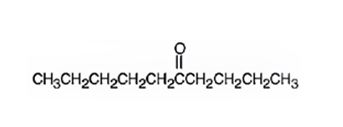
a)

Interpretation:
The product formed when 5-decyne reacts with H2 in the presence of Lindlar catalyst.
Concept introduction:
To predict:
The product formed when 5-decyne reacts with H2 in the presence of Lindlar catalyst.
Answer to Problem 32AP
The product formed when 5-decyne reacts with H2 in the presence of Lindlar catalyst is cis-5-decene

Explanation of Solution
When 5-decyne reacts with hydrogen in the presence of Lindlar catalyst, the addition of hydrogens to both carbons in triple bond takes place resulting in the formation of cis-5-decene.

The product expected when 5-decyne reacts with H2 in the presence of Lindlar catalyst is cis-5-decene.

b)

Interpretation:
The product formed when 5-decyne reacts with Li in ammonia.
Concept introduction:
Alkynes can be reduced by treatment with hydrogen in the presence of a catalyst. The hydrogenation occurs with anti stereochemistry to give a trans-alkene as product if Li in ammonia is used.
To predict:
The product formed when 5-decyne reacts with Li in ammonia.
Answer to Problem 32AP
The product formed when 5-decyne reacts with Li in ammonia is trans-5-decene.

Explanation of Solution
When 5-decyne reacts with hydrogen in the presence of Li in ammonia, the addition of hydrogens to both carbons in triple bond takes place following antistereochemistry resulting in the formation of trans-5-decene.

The product expected when 5-decyne reacts with Li in ammonia is trans-5-decene.

c)

Interpretation:
The product formed when 5-decyne reacts with one equivalent of bromine.
Concept introduction:
Alkynes undergo addition reactions with anti stereochemistry when treated with bromine. When treated with one equivalent of bromine a trans-dibromoalkene results as product by the addition of bromine atoms to the carbons in triple bond from opposite faces.
To predict:
The product formed when 5-decyne reacts with one equivalent of bromine.
Answer to Problem 32AP
The product formed when 5-decyne reacts with one equivalent of bromine is trans-5,6-dibromo-5-hexene.

Explanation of Solution
When 5-decyne reacts with bromine, the addition of bromine to both carbons in triple bond takes place following anti stereochemistry, resulting in the formation of trans-5,6-dibromo-5-decene as the product.

The product formed when 5-decyne reacts with one equivalent of bromine is trans-5,6-dibromo-5-decene.

d)

Interpretation:
The product formed when 5-decyne reacts with BH3 in THF followed by with H2O2, OH-.
Concept introduction:
Alkynes get hydrated in the hydroboration oxidation reaction. The reaction occurs with syn stereochemistry following anti Markovnikov regiochemistry to produce an enol. The enol then tautomerizes to yield a
To predict:
The product formed when 5-decyne reacts with BH3 in THF followed by with H2O2, OH-.
Answer to Problem 32AP
The product formed when 5-decyne reacts with BH3 in THF followed by with H2O2, OH- is 6-decanone.

Explanation of Solution
When 5-decyne is treated with BH3 in THF followed by with H2O2, OH-, the reaction occurs with syn stereochemistry following anti Markovnikov regiochemistry to produce an enol. The enol then tautomerizes to yield a ketone as the product. The Boron and hence the OH group adds to the less highly substituted carbon in triple bond and H adds to the more highly substituted carbon atom in the triple bond to produce an enol. The enol then tautomerizes to yield the ketone as the product.

The product formed when 5-decyne reacts with BH3 in THF followed by with H2O2, OH-is 6-decanone.

e)

Interpretation:
The product formed when 5-decyne reacts with H2O, H2SO4 in the presence of HgSO4 is to be given.
Concept introduction:
When treated with H2O, H2SO4 in the presence of HgSO4 alkynes get hydrated to produce enols. The addition of water to unsymmetrical alkynes follows Markonikov regiochemistry while it cannot be applied in the case of symmetrical alkynes. The enols produced then undergo tautomerization to give a ketone as the product.
To predict:
The product formed when 5-decyne reacts with H2O, H2SO4 in the presence of HgSO4.
Answer to Problem 32AP
The product formed when 5-decyne reacts with H2O, H2SO4 in the presence of HgSO4 is 5-decanone.

Explanation of Solution
5-Decyne is a symmetrical alkyne. Hence Markonikov regiochemistry is not applicable. When treated with dilute H2SO4 in the presence of HgSO4, the OH group adds to a carbon in triple bond and H adds to the other carbon in triple bond to yield an enol. The enol then tautomerizes to yield the ketone, 5-decanone.

The product formed when 5-decyne reacts with H2O, H2SO4 in the presence of HgSO4 is 5-decanone.

f)

Interpretation:
The product formed when 5-decyne reacts with excess H2 in the presence of Pd/C is to be given.
Concept introduction:
When treated with excess H2, Pd/C catalyst the alkynes react with two molar equivalents of hydrogen to give the parent
To predict:
The product formed when 5-decyne reacts with excess H2 in the presence of Pd/C.
Answer to Problem 32AP
The product formed when 5-decyne reacts with excess H2 in the presence of Pd/C is n-decane.

Explanation of Solution
When 5-Decyne is treated with excess H2 in the presence of Pd/C, two molar equivalents of hydrogens add to the triple bond. The corresponding alkane, n-decane is the product.

The product formed when 5-decyne reacts with excess H2 in the presence of Pd/C is n-decane.

Want to see more full solutions like this?
Chapter 9 Solutions
EBK ORGANIC CHEMISTRY
- can someone draw out the reaction mechanism for this reaction showing all the curly arrows and 2. Draw the GPNA molecule and identify the phenylalanine portion. 3. Draw L-phenylalanine with the correct stereochemistryarrow_forwardWhat is the reaction mechanism for this?arrow_forwardPredict the major products of both organic reactions. Be sure to use wedge and dash bonds to show the stereochemistry of the products when it's important, for example to distinguish between two different major products. esc esc Explanation Check 2 : + + X H₁₂O + Х ง WW E R Y qab Ccaps lock shift $ P X Click and drag to start drawing a structure. © 2025 McGraw Hill LLC. All Rights Reserved. Terms of Use | Privacy Center | Accessibility Bil T FR F18 9 G t K L Z X V B N M control opption command command T C darrow_forward
- Draw the Markovnikov product of the hydrohalogenation of this alkene. this problem. Note for advanced students: draw only one product, and don't worry about showing any stereochemistry. Drawing dash and wedge bonds has been disabled for caps lock Explanation Check 2 W E R + X 5 HCI Click and drag to start drawing a structure. © 2025 McGraw Hill LLC. All Rights Reserved. Terms of Use | Privacy Center | Accessibility Bil Y F G H K L ZZ X C V B N M control opption command F10 F10 command 4 BA Ar Carrow_forwardI don't understand why the amide on the top left, with the R attached to one side, doesn't get substituted with OH to form a carboxylic acid. And if only one can be substituted, why did it choose the amide it chose rather than the other amide?arrow_forwardesc Draw the Markovnikov product of the hydration of this alkene. Note for advanced students: draw only one product, and don't worry about showing any stereochemistry. Drawing dash and wedge bonds has been disabled for this problem. Explanation Check BBB + X 0 1. Hg (OAc)2, H₂O 2. Na BH 5 Click and drag to start drawing a structure. © 2025 McGraw Hill LLC. All Rights Reserved. Terms of Use | Privacy Center | Accessibility Bl P 豆 28 2 28 N 9 W E R T Y A S aps lock G H K L Z X C V B N M T central H command #e commandarrow_forward
- C A student proposes the transformation below in one step of an organic synthesis. There may be one or more products missing from the right-hand side, but there are no reagents missing from the left-hand side. There may also be catalysts, small inorganic reagents, and other important reaction conditions missing from the arrow. • Is the student's transformation possible? If not, check the box under the drawing area. . If the student's transformation is possible, then complete the reaction by adding any missing products to the right-hand side, and adding required catalysts, inorganic reagents, or other important reaction conditions above and below the arrow. • You do not need to balance the reaction, but be sure every important organic reactant or product is shown. (X) This transformation can't be done in one step. + Tarrow_forwardく Predict the major products of this organic reaction. If there aren't any products, because nothing will happen, check the box under the drawing area instead. No reaction. Explanation Check OH + + ✓ 2 H₂SO 4 O xs H₂O 2 Click and drag to start drawing a structure. © 2025 McGraw Hill LLC. All Rights Reserved. Terms of Use | Privacy Centerarrow_forwardDraw the skeletal ("line") structure of 1,3-dihydroxy-2-pentanone. Click and drag to start drawing a structure. X Parrow_forward
- Predicting edict the major products of this organic reaction. If there aren't any products, because nothing will happen, check the box under the drawing area instead. + No reaction. Explanation Check HO Na O H xs H₂O 2 Click and drag to start drawing a structure. © 2025 McGraw Hill LLC. All Rights Reserved. Terms of Use | Privacy Center Iarrow_forwardChoosing reagents and conditions for acetal formation or hydrolysis 0/5 A student proposes the transformation below in one step of an organic synthesis. There may be one or more products missing from the right-hand side, but there are no reagents missing from the left-hand side. There may also be catalysts, small inorganic reagents, and other important reaction conditions missing from the arrow. • Is the student's transformation possible? If not, check the box under the drawing area. If the student's transformation is possible, then complete the reaction by adding any missing products to the right-hand side, and adding required catalysts, inorganic reagents, or other important reaction conditions above and below the arrow. • You do not need to balance the reaction, but be sure every important organic reactant or product is shown. + This transformation can't be done in one step. 5 I H Autumn alo 值 Ar Barrow_forwardA block of copper of mass 2.00kg(cp = 0.3851 .K) and g temperature 0°C is introduced into an insulated container in which there is 1.00molH, O(g) at 100°C and 1.00 2 atm. Note that C P = 4.184. K for liquid water, and g that A H = 2260 for water. vap g Assuming all the steam is condensed to water, and that the pressure remains constant: (a) What will be the final temperature of the system? (b) What is the heat transferred from the water to the copper? (c) What is the entropy change of the water, the copper, and the total system?arrow_forward
 ChemistryChemistryISBN:9781305957404Author:Steven S. Zumdahl, Susan A. Zumdahl, Donald J. DeCostePublisher:Cengage Learning
ChemistryChemistryISBN:9781305957404Author:Steven S. Zumdahl, Susan A. Zumdahl, Donald J. DeCostePublisher:Cengage Learning ChemistryChemistryISBN:9781259911156Author:Raymond Chang Dr., Jason Overby ProfessorPublisher:McGraw-Hill Education
ChemistryChemistryISBN:9781259911156Author:Raymond Chang Dr., Jason Overby ProfessorPublisher:McGraw-Hill Education Principles of Instrumental AnalysisChemistryISBN:9781305577213Author:Douglas A. Skoog, F. James Holler, Stanley R. CrouchPublisher:Cengage Learning
Principles of Instrumental AnalysisChemistryISBN:9781305577213Author:Douglas A. Skoog, F. James Holler, Stanley R. CrouchPublisher:Cengage Learning Organic ChemistryChemistryISBN:9780078021558Author:Janice Gorzynski Smith Dr.Publisher:McGraw-Hill Education
Organic ChemistryChemistryISBN:9780078021558Author:Janice Gorzynski Smith Dr.Publisher:McGraw-Hill Education Chemistry: Principles and ReactionsChemistryISBN:9781305079373Author:William L. Masterton, Cecile N. HurleyPublisher:Cengage Learning
Chemistry: Principles and ReactionsChemistryISBN:9781305079373Author:William L. Masterton, Cecile N. HurleyPublisher:Cengage Learning Elementary Principles of Chemical Processes, Bind...ChemistryISBN:9781118431221Author:Richard M. Felder, Ronald W. Rousseau, Lisa G. BullardPublisher:WILEY
Elementary Principles of Chemical Processes, Bind...ChemistryISBN:9781118431221Author:Richard M. Felder, Ronald W. Rousseau, Lisa G. BullardPublisher:WILEY





